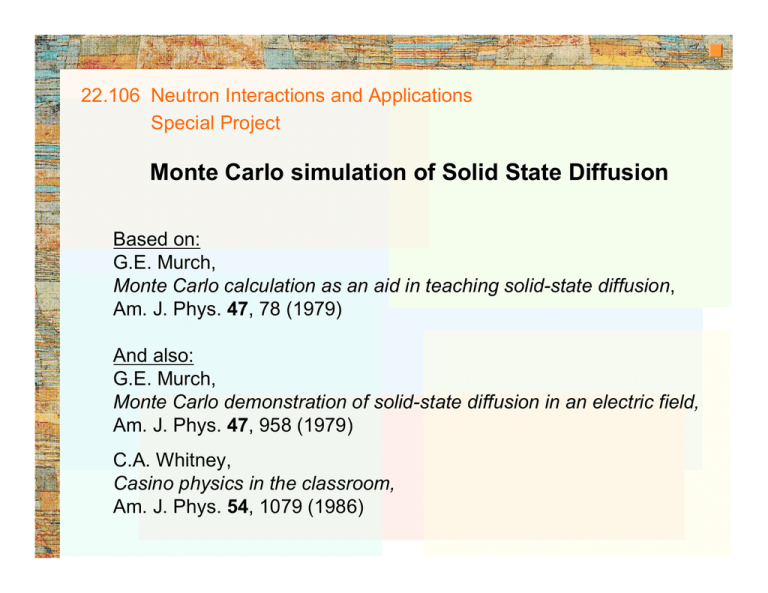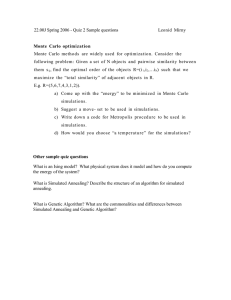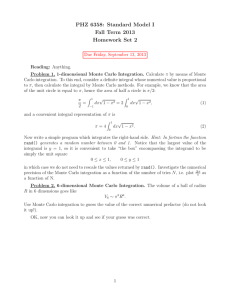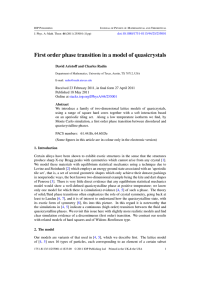Monte Carlo simulation of Solid State Diffusion
advertisement

22.106 Neutron Interactions and Applications Special Project Monte Carlo simulation of Solid State Diffusion Based on: G.E. Murch, Monte Carlo calculation as an aid in teaching solid-state diffusion, Am. J. Phys. 47, 78 (1979) And also: G.E. Murch, Monte Carlo demonstration of solid-state diffusion in an electric field, Am. J. Phys. 47, 958 (1979) C.A. Whitney, Casino physics in the classroom, Am. J. Phys. 54, 1079 (1986) Motivation Acquire a broader perspective on Monte Carlo simulations Monte Carlo methods in science = using randomness to solve problems (Metropolis) Calculation of thermodynamical properties of a system of many interacting particles Importance sampling – numerical evaluation of integrals / weighted sums Mathematically similar: A = ∑ p ( χ i ) A( χ i ) or i ∫ p( χ ) A( χ )dχ where χ belongs to a space of possible configurations/values → A = ∑ A( χ ) i i SAMPLED Optimization – search for global minima → “to go downhill, and uphill once in a while…” Simulations of physical phenomena ☺ Creativity to interpret different phenomena probabilistically or to identify stochastic behavior other… Simulations of physical phenomena Radiation transport - MCNP Neutrons (or photons) travel across a given material where they can be scattered, absorbed, leak ... go through fission (neutrons), pair production (photons), etc. Absorption in space / Nuclear decay in time Particles that survive with probability p or don’t with probability 1-p → laws of the type e-px, e-pt where p is related to c.x., life-times, etc. Random walks Solid-state diffusion other… Statement of the problem initially after certain time t → c( x, t ) = concentrat ion of along the xˆ direction c( x1 , t ) = 2 x ∂c ∂x ∂J ∂c =− ∂x ∂t J = −D Fick’s law eq. of continuity Analytical solution: (for infinite medium ⇒ no boundaries) Same type of atoms: self-diffusion ∂ 2 c ∂c D 2 = ∂x ∂t c0 c ( x, t ) = e 2 πDt x2 − 4 Dt (time dependent) diffusion eq. • Gaussian profile 2 • ∆x = 2 t D Monte Carlo simulation Atomistic approach: the vacancy mechanism Causes for vacancies: • Impurity doping • Radiation damage • Thermal activation → the vacancy follows a random walk the vacancy moves and interchanges places with the atoms keep track of the wandering of the atoms: final distance traveled = ∆x MC simulation computer = finite medium ⇓ Periodic Boundary Conditions (for the vacancy) histogram trajectory of the vacancy in 3D dynamics in 2D Recovering results… Observations we can calculate D = ∆ x 2 / 2t with ∆x 2 = M 1 M 2 x ∑ i M = # particles tracked i =1 or by fitting: Ln(c) = const − x 2 /( 4 Dt ) D = 2x10-5 - 1.4x10-5 (1.36x10-5 in the paper) (physical units) PBC ≠ infinite medium, because there is a maximum distance! To simulate an infinite medium at large t, we must take a larger lattice Conclusions • We simulated solid state self diffusion using a Monte Carlo algorithm • MC can be used to simulate very different systems & dynamics • Random numbers are very useful to solve a large variety of problems.







